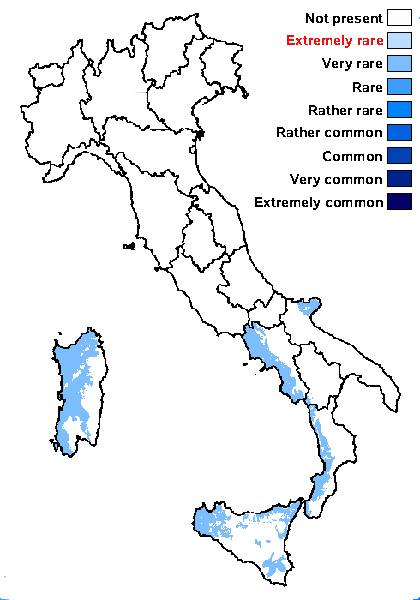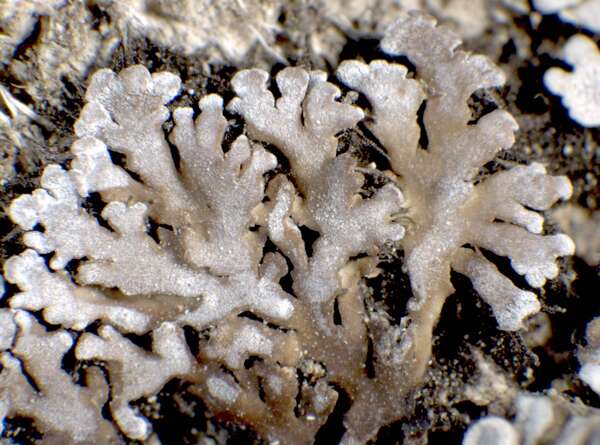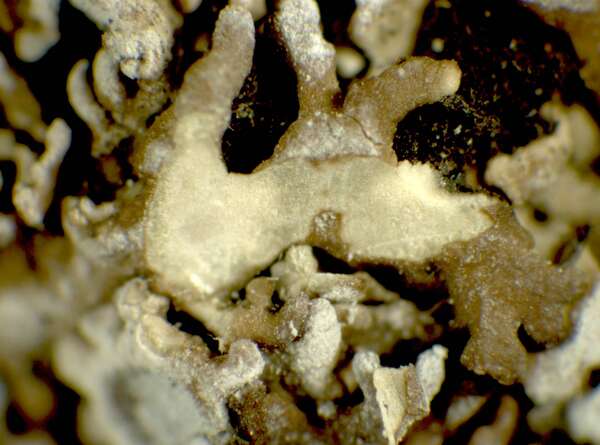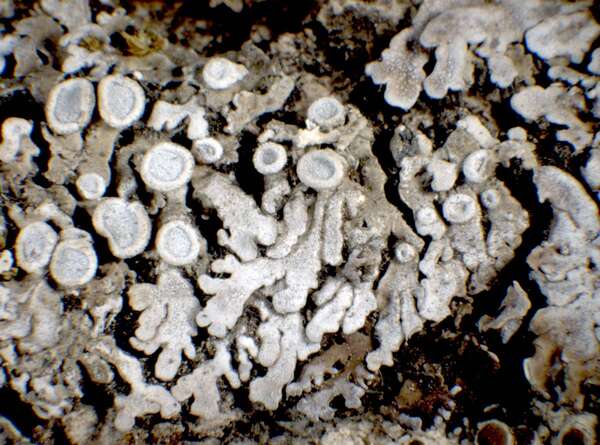Physconia subpulverulenta (Szatala) Poelt var. subpulverulenta
Nova Hedwigia, 12: 127, 1966. Basionym: Physcia subpulverulenta Szatala - Borbasia, 3: 135, 1941.
Synonyms:
Distribution: C - Sar (Zedda 1995, 2002, 2002b, Zedda & al. 2001, Otte & al. 2002, Rizzi & al. 2011, Cossu 2013, Di Nuzzo & al. 2022). S - Camp (Catalano & al. 2010, 2016), Pugl (Garofalo & al. 1999), Bas (Nimis & Tretiach 1999), Cal (Otte & al. 2002, Puntillo 2011), Si (Otte & al. 2002).
Description: Thallus foliose, heteromerous, dorsiventral, narrow-lobed, rather tightly adpressed, forming up to 7 cm wide rosettes. Lobes elongated, 0.5-1(-1.5) mm wide, flat, of variable colour, from brown in weakly pruinose forms to white in strongly pruinose ones, with some white pruina at least at tips, often with adventive lobules in central part of thallus. Lower surface mostly black (whitish in marginal parts), with dense, dark, squarrose rhizines. Upper and lower cortex prosoplectenchymatous, the hyphae mostly running perpendicularly to the surface; medulla yellowish. Apothecia common, lecanorine, sessile, to 3(-4) mm across, with a usually white-pruinose disc and a persistent, often lobulate thalline margin. Asci 8-spored, elongate-clavate, very thin-walled, with a K/I+ blue, tall tholus penetrated by a faintly amyloid apical cushion, the wall K/I-, surrounded by a K/I+ blue outer layer, Lecanora-type. Ascospores 1-septate, brown, ellipsoid, 24-30 x 12-18 μm, Physconia-type. Pycnidia laminal, immersed. Conidia bacilliform. Photobiont chlorococcoid. Spot tests: upper cortex K-, C-, KC-, P-; medulla K+ bright yellow, C+ yellow, KC+ yellow-orange, P-. Chemistry: medulla with variolaric acid. Note: a mainly Mediterranean-Atlantic lichen of isolated trees. The taxonomic significance of yellow medullary pigments in Physconia still awaits a satisfactory evaluation. This taxon is rare in Italy, and restricted to warm-humid Tyrrhenian areas. It was included in the Italian red list of epiphytic lichens as “Data Deficient” (Nascimbene & al. 2013c).
Growth form: Foliose, narrow lobed
Substrata: bark
Photobiont: green algae other than Trentepohlia
Reproductive strategy: mainly sexual
Most common in areas with a humid-warm climate (e.g. most of Tyrrenian Italy)
Commonnes-rarity: (info)
Alpine belt: absent
Subalpine belt: absent
Oromediterranean belt: absent
Montane belt: absent
Submediterranean belt: absent
Padanian area: absent
Humid submediterranean belt: very rare
Humid mediterranean belt: very rare
Dry mediterranean belt: absent

Predictive model
Herbarium samples
Growth form: Foliose, narrow lobed
Substrata: bark
Photobiont: green algae other than Trentepohlia
Reproductive strategy: mainly sexual
Most common in areas with a humid-warm climate (e.g. most of Tyrrenian Italy)
Commonnes-rarity: (info)
Alpine belt: absent
Subalpine belt: absent
Oromediterranean belt: absent
Montane belt: absent
Submediterranean belt: absent
Padanian area: absent
Humid submediterranean belt: very rare
Humid mediterranean belt: very rare
Dry mediterranean belt: absent

Predictive model
| Herbarium samples |
 Index Fungorum
Index Fungorum
 GBIF
GBIF





